Electrics must work harder at pleasing the other senses and the whole play around novelty in design and features being big differentiators is understandable. There is no drama under the bonnet, but they can move you alright, with how they can convert electrical energy into kinetic energy; the more grin-inducing, the better. A case in point is the BMW iX, a ‘green’ hulk that sits in the parallel universe of polarities and attempts to defy the physics that the X5 — its ICE counterpart — must put up with. The iX’s unique design and its ultra-plush cabin are big USPs in the Indian context where novelty may well be the reason why luxury car buyers may be tempted to go electric. These are buyers who will likely have a couple of other luxury ICE vehicles in their garage already.

The iX has been one of the best-selling electric SUVs in the market over the last one year. So much so that BMW hasn’t been able to keep up with the demand and the iX’s availability has been hamstrung by allocations, much like supercars. In fact, BMW hasn’t had one consistently in its India press fleet, having been overwhelmed by the response from customers. So, extensive test drives of the iX have had to wait for more test mules to arrive. Finally, last week I got to spend some quality time behind the wheel of this unique SUV. Is this the luxe electric SUV you should buy?

Design
When I first saw the iX at its unveil last year, the design seemed a bit awkward. Futuristic, yes, but some of the exterior elements seemed exaggerated and excessive, the oversized kidney grille being just one of them. But, a year on and after seeing a few on the road, the iX seems different, and yet, completely comfortable in its skin.

There is also what seems like this slight mismatch between the front and rear design, with the front being sharper and the rear looking curvier. And yet, when one steps back the iX’s design seems to come together to form quite an appealing unit. With the BMWi language writ clearly on its face, the iX’s modernity of design is quite apparent. The use of more angular elements, the discreet LED highlighting and the sleeker electrical elements creating an entirely new light signature give it a very different design impact. The surfacing of the large body panels is just that bit more unbroken and that in turn seems to make the shut lines tighter. There is also the play of light and shadow which enables some of the design elements like the wheel arches to pop into view.
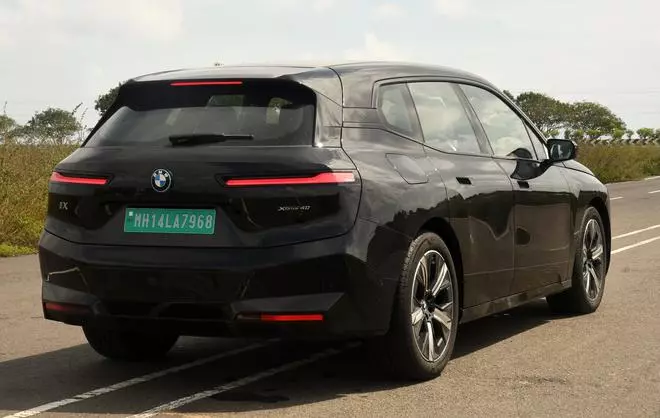
There is also what seems like this slight mismatch between the front and rear design, with the front being sharper and the rear looking curvier | Photo Credit: BIJOY GHOSH
The vertical nose of the iX and the XL design elements at the front give it a strong, wide SUV stance. The overall profile is both upright and yet seems inspired by an SUV coupe like the X6. The cabin is said to be bigger than the X5 and BMW says that the large 21-inch wheels reflect the dynamism of the X7. The oversized air-curtains at the front, the radiating metallic triangular elements in the grille and the rear fender design are some of the most interesting design elements in the iX’s exterior. The stalked door mirrors and recessed door handles are meant to improve aerodynamics. And the overall volume of the iX is also oriented towards maxing aero performance. The frameless doors add more drama to the design.

The frameless doors add more drama to the design | Photo Credit: BIJOY GHOSH
Cabin
The iX’s interior is a treat for the senses. Starting from the warm aroma of leather, the textures of the open pore wood centre console with the slightly raised letters and logos for the control buttons and the crisp details on the elongated digital display, the cabin hits all the right hormonal chords in my brain. The iX cabin also looks much like a futuristic concept car with that very sci-fi-inspired steering wheel. Some of the elements in the cabin like the cut-crystal control knob and selector are a bit over-the-top for a BMW.

But thankfully, they are still extremely tastefully finished and go well together with the wood panel on the centre console. The quilted seats are extremely comfortable and constructed with generously large squabs; electrical adjustment is via cut-crystal controls on the door panel. The rear seats are also comfy with wide under-thigh support. The flat floor makes for easy movement within the cabin and allows for the floating centre console at the front. Multiple trim elements inside the cabin are said to be either recycled materials or have been sustainably sourced, including a fifth of all the plastics.

Some of the elements in the cabin like the cut-crystal control knob and selector are a bit over-the-top for a BMW but thankfully are still extremely tastefully finished | Photo Credit: BIJOY GHOSH
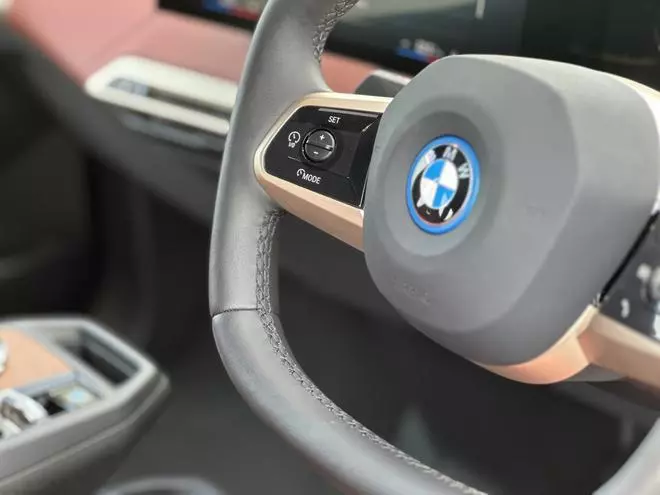
There are a number of digital displays that take digitisation and driver interface options to a new high. The 14.9-inch curved control display on top of the dashboard offers a new generation of iDrive and offers access to all key functions in the iX. A 12.3-inch instrument display behind the steering wheel offers more drive-related information and can mirror the navigation info.
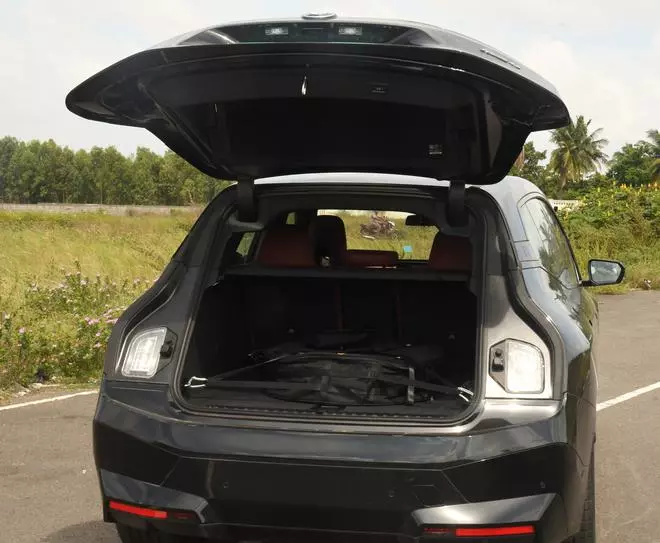

There is also a heads-up display to aid the driver with more handy info including turn-by-turn navigation. BMW Virtual Assistant and gesture control have been further refined for even better handsfree access to controls. The iX also gets a bunch of driver assistance features. The glass roof delivers a lot of light into the cabin and at the touch of a button can be made opaque for more privacy and reduced glare. Doors open electrically at the touch of a button. Race car-inspired hexagonal steering wheel seems difficult to use at first but feels good to hold and I quickly realise it is easy to use too.

Battery-Electric system
My test mule was the iX xDrive 40 with its twin motor set up — one each on either axle. The BMW eDrive Tech is one integrated drive unit and offers the combined power of two motors at 326hp (even though individual outputs of the two motors add up to a higher number), and the peak torque is 630Nm. The iX xDrive 40 is said to be capable of the 0-100 kmph sprint in 6.1 seconds, and the top speed is restricted to 200kmph. The WLTP-rated driving range is a maximum of 425 km. Real-world range is likely to be more like 300-350 km depending on your driving style. When delivered to me, the test mule display showed a driving range of 298 km with 85 per cent charge remaining in the battery pack.

The Driving mode (personal, sport and efficient) and regenerative braking level selected will also affect the driving range. There are four selectable regen levels, and there is a gear position B option which allows one pedal driving. It is also an all-wheel drive powertrain, so on the road iX lurches forward without any drama when I floor the pedal. Though it is not the most powerful version of the iX (the 50 and the M60 are quicker), it still pins me back into my seat and leaves the rest of the traffic behind at traffic lights with ease. The space age music crescendo as I accelerate hard is something I never got used to during my drive.
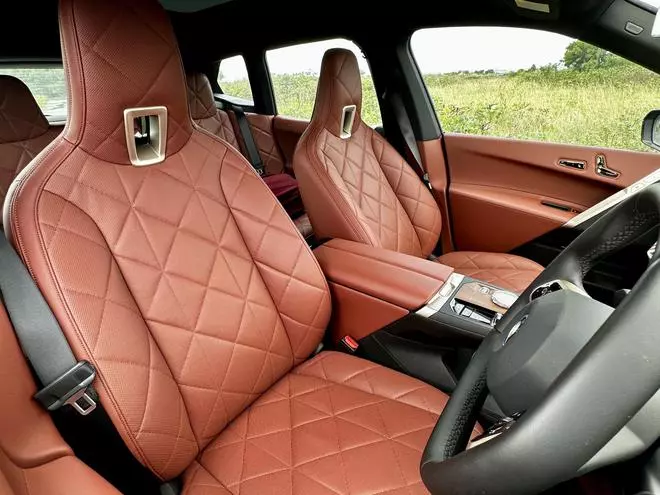
The quilted seats are extremely comfortable and constructed with generously large squabs
The twin lithium-ion battery itself is a 76.6kWh pack located under the floor of the iX. The pack can be charged either on a wall socket, or DC charging stations ranging from 50kW to 150kW with charging times varying from 7 hours via wall socket, or up to an hour and half for a 10 per cent to 80 per cent charge or 31 minutes for a similar top-up through a fast charger. The charging socket is CCS2 — the most widely adopted charging protocol currently. BMW can also supply the smart wall box for home use with a charging power of 11kW or in some markets 22kW being delivered. Buyers will also have access to fast chargers at BMW dealerships around the country.

Ride and handling
The BMW iX’s ride and handling are another highlight. The SAV (as BMW calls it) is constructed with a high-strength steel frame and features extensive use of carbon fibre for the life cell. The weight distribution is an even 50:50 for the front and rear. The battery pack under the floor offers additional benefits from the lower centre of gravity. Though this is an advantage for most EVs, how that is leveraged for improving ride and handling varies. And in the iX this certainly has been used to its advantage.
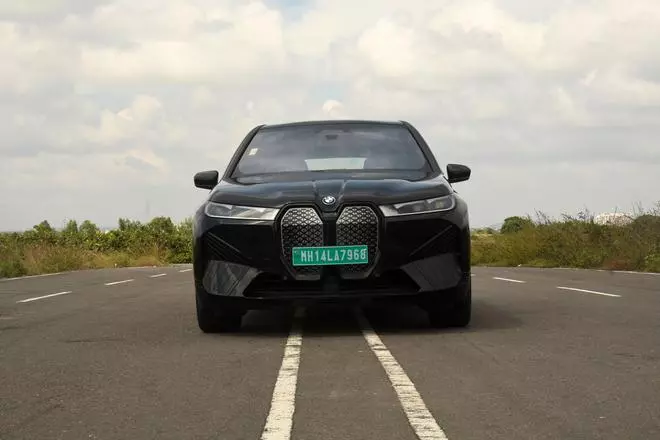
The ride is plush despite the absence of air suspension. There is a lot of road isolation and with the cabin being so quiet, it was a bit disconcerting for the first few minutes of my test drive. The ride does get more engaging and the iX can be pushed into corners. Though I do sense the weight of the vehicle when tackling turns, it doesn’t feel too bottom-heavy. But most buyers who like to be chauffeured will like the way the iX manages to iron out broken tarmac and undulations on the road. Speed breakers are no problem too and there is only the odd bad patch or poorly closed manhole covers that send some feedback into the cabin.

Bottom Line
The iX is meant for a very niche audience. Yet, its appeal extends beyond its relatively green footprint into being a vehicle of choice even for other drivers who want to buy into the novelty of the iX. It is a CBU (completely built unit) import and the ex-showroom price of ₹1.21 crore is a bit on the higher side but the iX compensates with the number of unique features that buyers can expect.






Comments
Comments have to be in English, and in full sentences. They cannot be abusive or personal. Please abide by our community guidelines for posting your comments.
We have migrated to a new commenting platform. If you are already a registered user of TheHindu Businessline and logged in, you may continue to engage with our articles. If you do not have an account please register and login to post comments. Users can access their older comments by logging into their accounts on Vuukle.